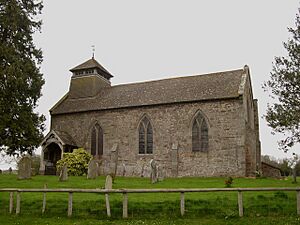Brinsop facts for kids
Quick facts for kids Brinsop |
|
|---|---|
 St George's church |
|
| Civil parish |
|
| Unitary authority | |
| Ceremonial county | |
| Region | |
| Country | England |
| Sovereign state | United Kingdom |
| EU Parliament | West Midlands |
Brinsop is a small village in Herefordshire, England. It's about 6 miles (10 km) north-west of the city of Hereford. Brinsop used to be its own parish, but in 1987, it joined with Wormsley to form the "Brinsop & Wormsley" parish.
Contents
Discover St George's Church in Brinsop
St George's church in Brinsop is a very old building from the early 1300s. It sits in a peaceful, wooded valley. Even though some of its original red sandstone has been taken over time, parts of its history are still very clear.
One special part is the carved stone above the door, called a tympanum. It was made around 1150–1160. This carving shows St George on horseback, like a knight fighting a serpent-dragon. This kind of mythical creature was a common design in Herefordshire at that time.
Inside the church, you can find two old stone coffin lids with carved crosses. The church has a main hall (nave) and a smaller area for the altar (chancel). These parts were added around 1320 and 1333–1340. The north aisle, which is a side section, was likely built after 1300. It has windows from the 1330s or 1340s.
Ancient Art: Medieval Wall Paintings
The church is home to amazing medieval wall paintings from the 1300s. On the south wall, you can see scenes like the Annunciation (when the Angel Gabriel visited Mary) and the Crucifixion of Christ. These paintings offer a glimpse into art from the early 14th century.
There's also a holy water basin, called a stoup, from the 1400s. The church also remembers the local Dansey family, who were important people in the Middle Ages. You can see a tablet for William Dansey (who died in 1708) and an even older stone inscription for another William Dansey from 1628.
Church Bells and Later Changes
The church bells are quite unique, with special Latin writings dedicated to Saints Michael, John, and Margaret.
The church was repaired and updated by an architect named William Chick in 1866–1867. During this time, the south porch and the bell tower on the west side were added. The roofs were also fixed. More improvements were made in the 1870s and 1880s, including new stained glass windows by Clayton & Bell in 1881.
Modern Updates: 20th-Century Alterations
In the 1920s, Sir Ninian Comper, another architect, made more changes to the church's inside. He added a beautiful alabaster screen, called a reredos, between the nave and the chancel. This screen is decorated with golden angel figures of St George and St Martin.
The chancel was restored in 1929, after new stained glass was put in the east window in 1923. A war memorial was also placed inside the chapel in 1920. In the churchyard, Comper designed a tomb in 1925 for Herbert Astley, who owned the local court.

